
Green-Wood Cemetery is a 478-acre (193 ha) cemetery in the western portion of Brooklyn, New York City. The cemetery is located between South Slope/Greenwood Heights, Park Slope, Windsor Terrace, Borough Park, Kensington, and Sunset Park, and lies several blocks southwest of Prospect Park. Its boundaries include, among other streets, 20th Street to the northeast, Fifth Avenue to the northwest, 36th and 37th Streets to the southwest, Fort Hamilton Parkway to the south, and McDonald Avenue to the east.

Mount Auburn Cemetery, located in Cambridge and Watertown, Massachusetts, is the first rural or garden cemetery in the United States. It is the burial site of many prominent Boston Brahmins, and is a National Historic Landmark.
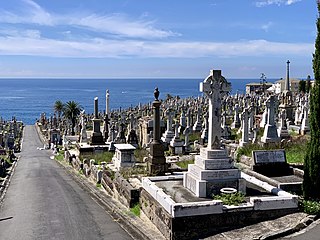
The Waverley Cemetery is a heritage-listed cemetery on top of the cliffs at Bronte in the eastern suburbs of Sydney, New South Wales, Australia. Opened in 1877 and built by R. Watkins and P. Beddie, the cemetery is noted for its largely intact Victorian and Edwardian monuments. It is regularly cited as being one of the most beautiful cemeteries in the world. The cemetery contains the graves of many significant Australians including the poet Henry Lawson. Also known as General Cemetery Waverley, it was added to the New South Wales State Heritage Register on 28 October 2016.
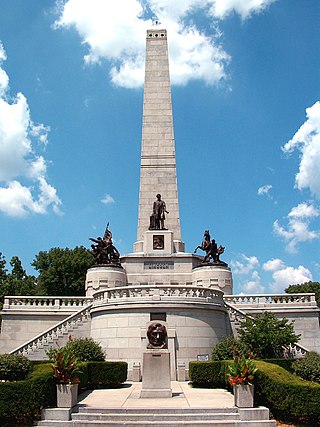
The Lincoln Tomb is the final resting place of Abraham Lincoln, the 16th President of the United States; his wife Mary Todd Lincoln; and three of their four sons: Edward, William, and Thomas. It is located in Oak Ridge Cemetery in Springfield, Illinois.
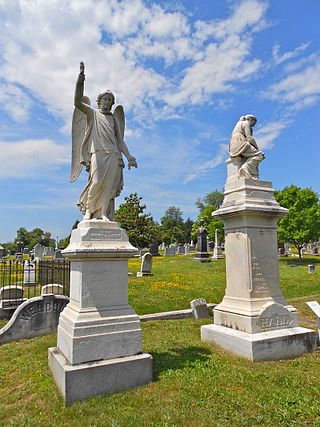
The Congressional Cemetery, officially Washington Parish Burial Ground, is a historic and active cemetery located at 1801 E Street, SE, in Washington, D.C., on the west bank of the Anacostia River. It is the only American "cemetery of national memory" founded before the Civil War. Over 65,000 individuals are buried or memorialized at the cemetery, including many who helped form the nation and the city of Washington in the early 19th century.

Oakland Cemetery is one of the largest cemetery green spaces in Atlanta, Georgia, U.S. Founded as Atlanta Cemetery in 1850 on six acres (2.4 hectares) of land southeast of the city, it was renamed in 1872 to reflect the large number of oak and magnolia trees growing in the area. By that time, the city had grown and the cemetery had enlarged correspondingly to the current 48 acres (190,000 m2). Since then, Atlanta has continued to expand so that the cemetery is now located in the center of the city. Oakland is an excellent example of a Victorian-style cemetery, and reflects the "garden cemetery" movement started and exemplified by Mount Auburn Cemetery in Massachusetts.

Laurel Hill Cemetery, also called Laurel Hill East to distinguish from West Laurel Hill Cemetery in Bala Cynwyd, is a historic rural cemetery in the East Falls neighborhood of Philadelphia. Founded in 1836, it was the second major rural cemetery in the United States after Mount Auburn Cemetery in Boston, Massachusetts.

Chippiannock Cemetery is a rural cemetery located on 12th Street and 31st Avenue in Rock Island, Illinois, United States. The word “Chippiannock” is a Native American term which means “place of the dead”. It was listed on the National Register of Historic Places in 1994.
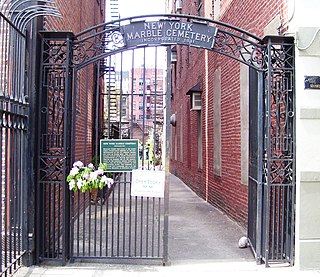
The New York Marble Cemetery is a burial ground established in 1830 in what is now the East Village of Manhattan. It occupies the interior of the block bounded by 2nd Street, Second Avenue, 3rd Street, and the Bowery. It is entered through an alleyway with an iron gate at each end, located between 41 and 43 Second Avenue. About 2,100 burials are recorded in the cemetery's written registers, most from prominent professional and merchant families in New York City.
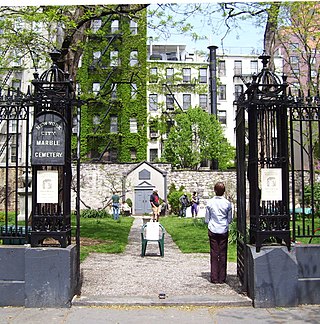
The New York City Marble Cemetery is a historic cemetery founded in 1831, and located at 52-74 East 2nd Street between First and Second Avenues in the East Village neighborhood of Manhattan, New York City. The cemetery has 258 underground burial vaults constructed of Tuckahoe marble on the site.

Magnolia Cemetery is a historic city cemetery located in Mobile, Alabama. Filled with many elaborate Victorian-era monuments, it spans more than 100 acres (40 ha). It served as Mobile's primary, and almost exclusive, burial place during the 19th century. It is the final resting place for many of Mobile's 19th- and early 20th-century citizens. The cemetery is roughly bounded by Frye Street to the north, Gayle Street to the east, and Ann Street to the west. Virginia Street originally formed the southern border before the cemetery was expanded and now cuts east–west through the center of the cemetery. Magnolia contains more than 80,000 burials and remains an active, though very limited, burial site today.
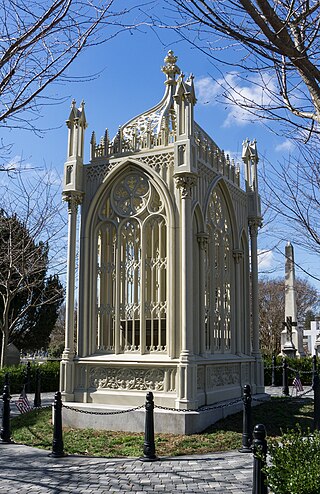
The James Monroe Tomb is the burial place of U.S. President James Monroe in Hollywood Cemetery, Richmond, Virginia, United States. The principal feature of the tomb is an architecturally unusual cast iron cage, designed by Albert Lybrock and installed in 1859 after Monroe's body was moved from Marble Cemetery in New York City. The tomb was declared a National Historic Landmark in 1971 for its unique architecture. To Richmonders it is colloquially known as The Birdcage.

Oakwood Cemetery is a nonsectarian rural cemetery in northeastern Troy, New York, United States. It operates under the direction of the Troy Cemetery Association, a non-profit board of directors that deals strictly with the operation of the cemetery. It was established in 1848 in response to the growing rural cemetery movement in New England and went into service in 1850. The cemetery was designed by architect John C. Sidney and underwent its greatest development in the late 19th century under superintendent John Boetcher, who incorporated rare foliage and a clear landscape design strategy. Oakwood was the fourth rural cemetery opened in New York and its governing body was the first rural cemetery association created in the state.

Millville Cemetery is located on East Shelby Road in Millville, New York, United States. It was established in 1871 as a rural cemetery, expanding on an early burial ground.

The Saint Michael and All Angels Episcopal Church is a historic church located in rural Cambridge Township in northwestern Lenawee County, Michigan. The church was designated as a Michigan Historic Site on October 2, 1980. On February 4, 2004, the church, along with the adjacent Cambridge Township Cemetery, was added to the National Register of Historic Places.

The English coastal city of Brighton and Hove, made up of the formerly separate Boroughs of Brighton and Hove in East Sussex, has a wide range of cemeteries throughout its urban area. Many were established in the mid-19th century, a time in which the Victorian "cult of death" encouraged extravagant, expensive memorials set in carefully cultivated landscapes which were even recommended as tourist attractions. Some of the largest, such as the Extra Mural Cemetery and the Brighton and Preston Cemetery, were set in particularly impressive natural landscapes. Brighton and Hove City Council, the local authority responsible for public services in the city, manages seven cemeteries, one of which also has the city's main crematorium. An eighth cemetery and a second crematorium are owned by a private company. Many cemeteries are full and no longer accept new burials. The council maintains administrative offices and a mortuary at the Woodvale Cemetery, and employs a coroner and support staff.

Oakdale Memorial Gardens, formerly Oakdale Cemetery, is located in east-central Davenport, Iowa. It contains a section for the burial of pets called the Love of Animals Petland. In 2015, the cemetery was listed as an historic district on the National Register of Historic Places, and as a local landmark on the Davenport Register of Historic Properties. It is also listed on the Network to Freedom, a National Park Service registry for sites associated with the Underground Railroad.

Woodland Cemetery is a historic rural cemetery located at 6901 Woodland Avenue in Cleveland, Ohio. Established in 1853, it became Cleveland's main public cemetery after its founding and remained so for the next half-century. It fell into extreme disrepair, and most of its outstanding architectural features dismantled or demolished. In 1986, Woodland Cemetery was added to the National Register of Historic Places. The cemetery has since undergone restoration.

The Historic Cemeteries of New Orleans, New Orleans, United States, are a group of forty-two cemeteries that are historically and culturally significant. These are distinct from most cemeteries commonly located in the United States in that they are an amalgam of the French, Spanish, and Caribbean historical influences on the city of New Orleans in addition to limitations resulting from the city's high water table. The cemeteries reflect the ethnic, religious, and socio-economic heritages of the city. Architecturally, they are predominantly above ground tombs, family tombs, civic association tombs, and wall vaults, often in neo-classical design and laid out in regular patterns similar to city streets. They are at times referred to colloquially as “Cities of the Dead”, and some of the historic cemeteries are tourist destinations.

Oakland Cemetery is a historic cemetery at 1007 North Main Street in Princeton, Illinois. The cemetery originated in 1836, five years after Princeton's founding, and was originally owned by Reverend Lucien Farnham as a burial ground for members of the Hampshire Colony Congregational Church. The city of Princeton leased the burial ground from the church in 1862 and bought a large plot of adjacent land, and by the next year they had combined the two plots and named them Oakland Cemetery after the oak trees there. Landscape architect L.L. Herron and surveyor Romanus Hodgman planned the grounds as a garden cemetery, a park-like style of cemetery which had become popular in the eastern United States at the time. The cemetery included a public picnic area, carriage paths, and a Gothic Revival office building. Many of the graves in the cemetery feature large, artistic monuments, including obelisks made from white bronze, statues of angels or the deceased, stone tree trunks, and Art Deco box tombs. The largest monument in the cemetery marks the grave of pioneer and local historian Nehemiah Matson; it is 34 feet (10 m) tall and made of 44 tons of granite, and it cost $4,600 when it was built in 1884.























